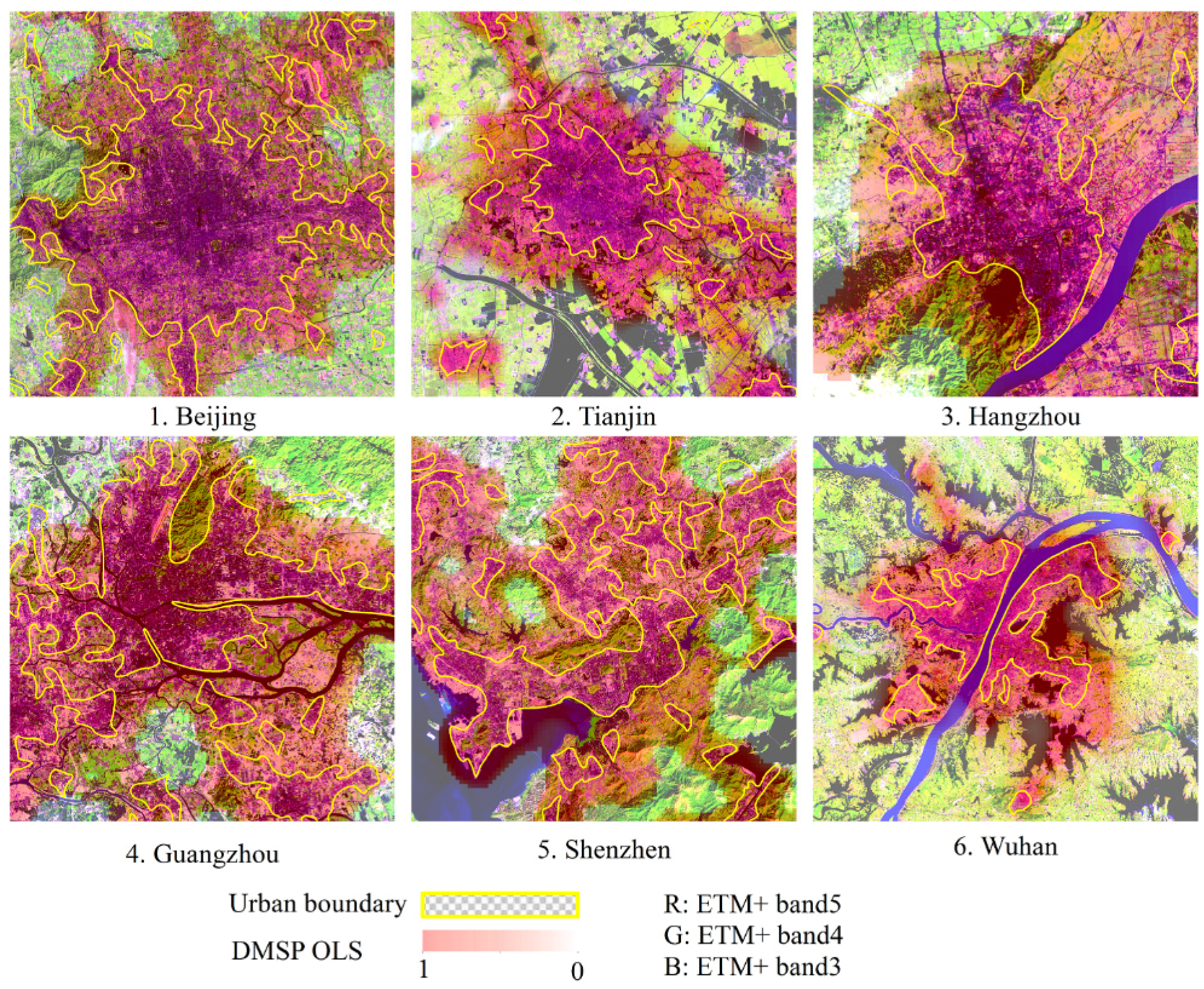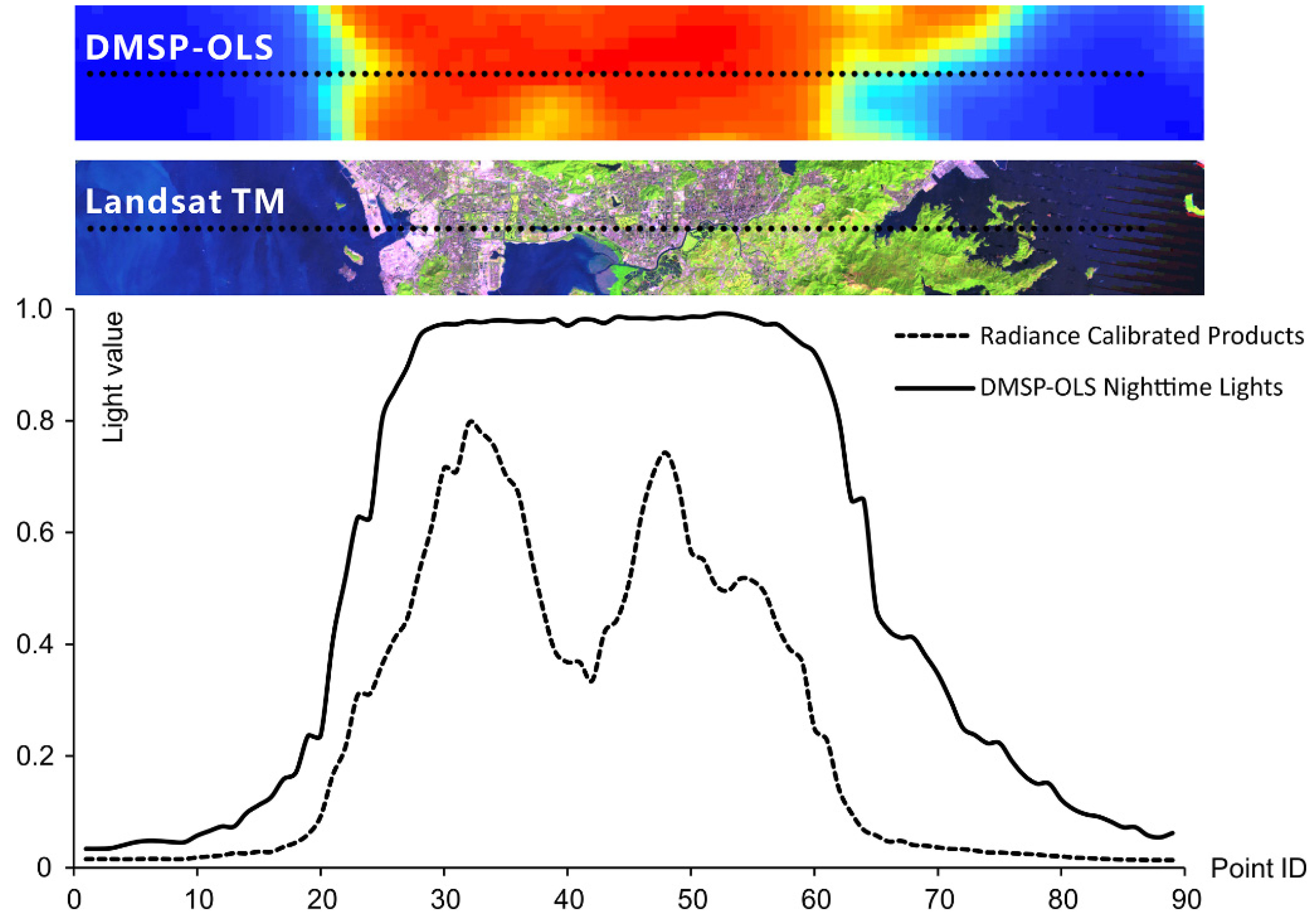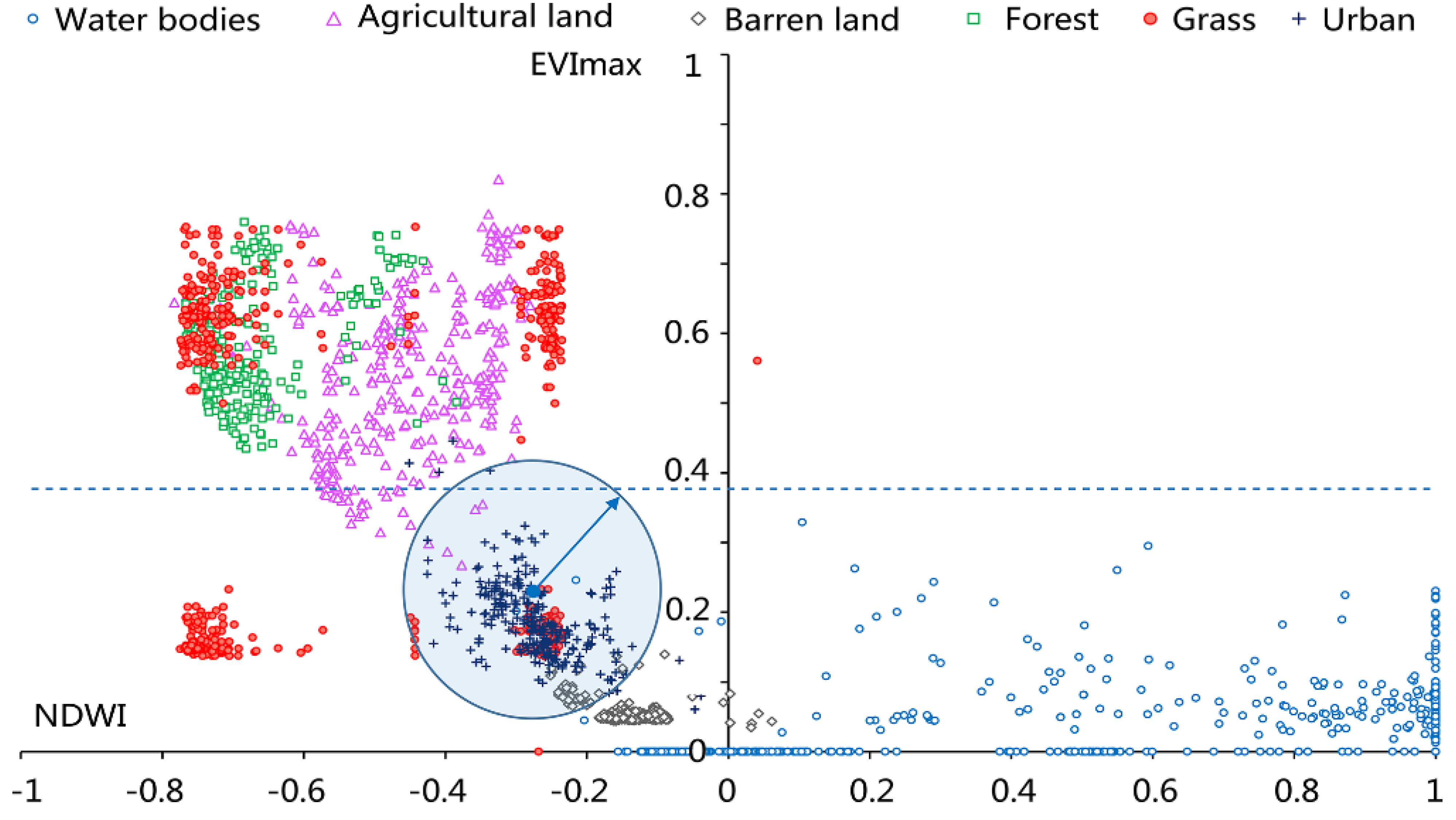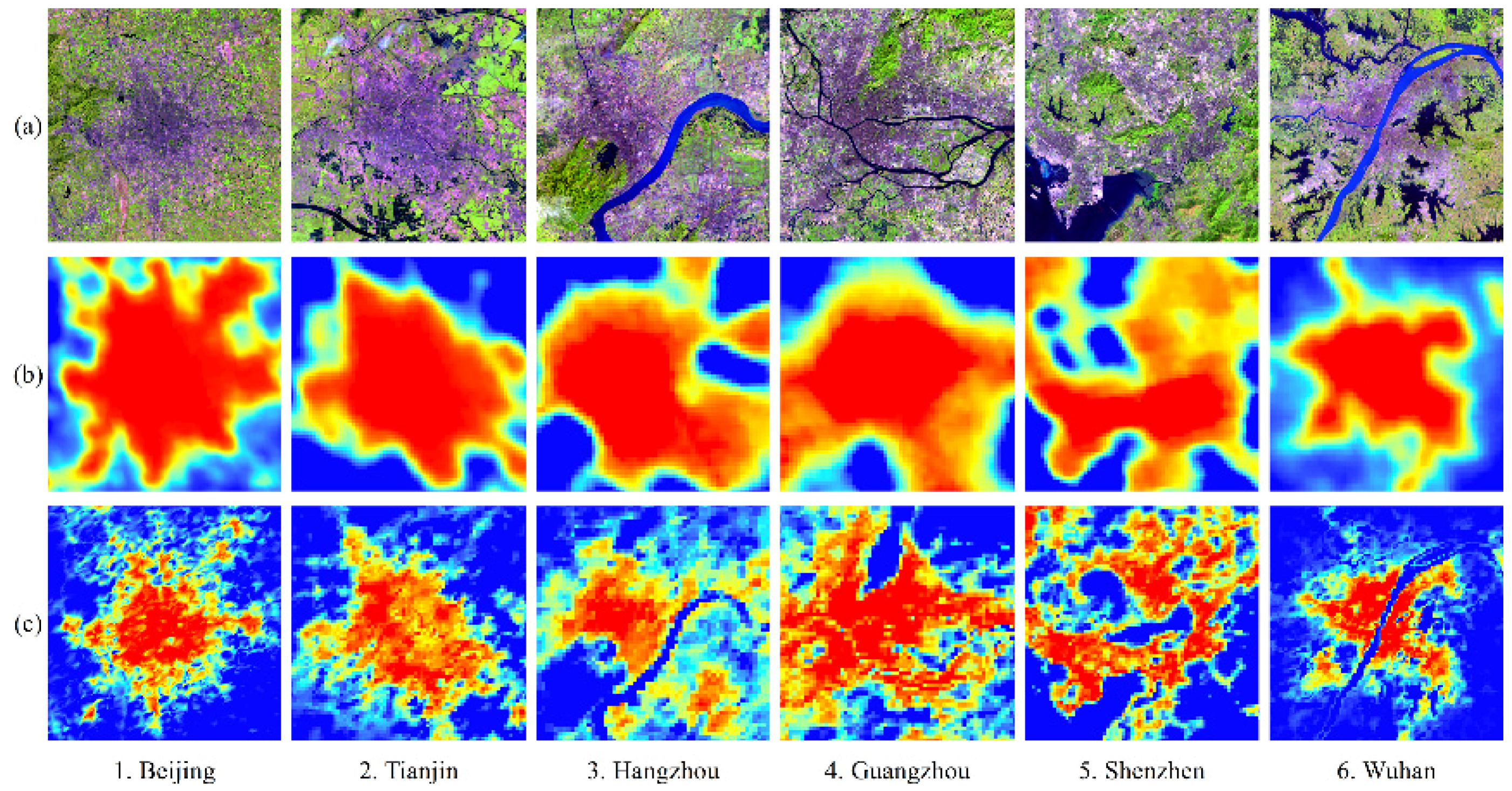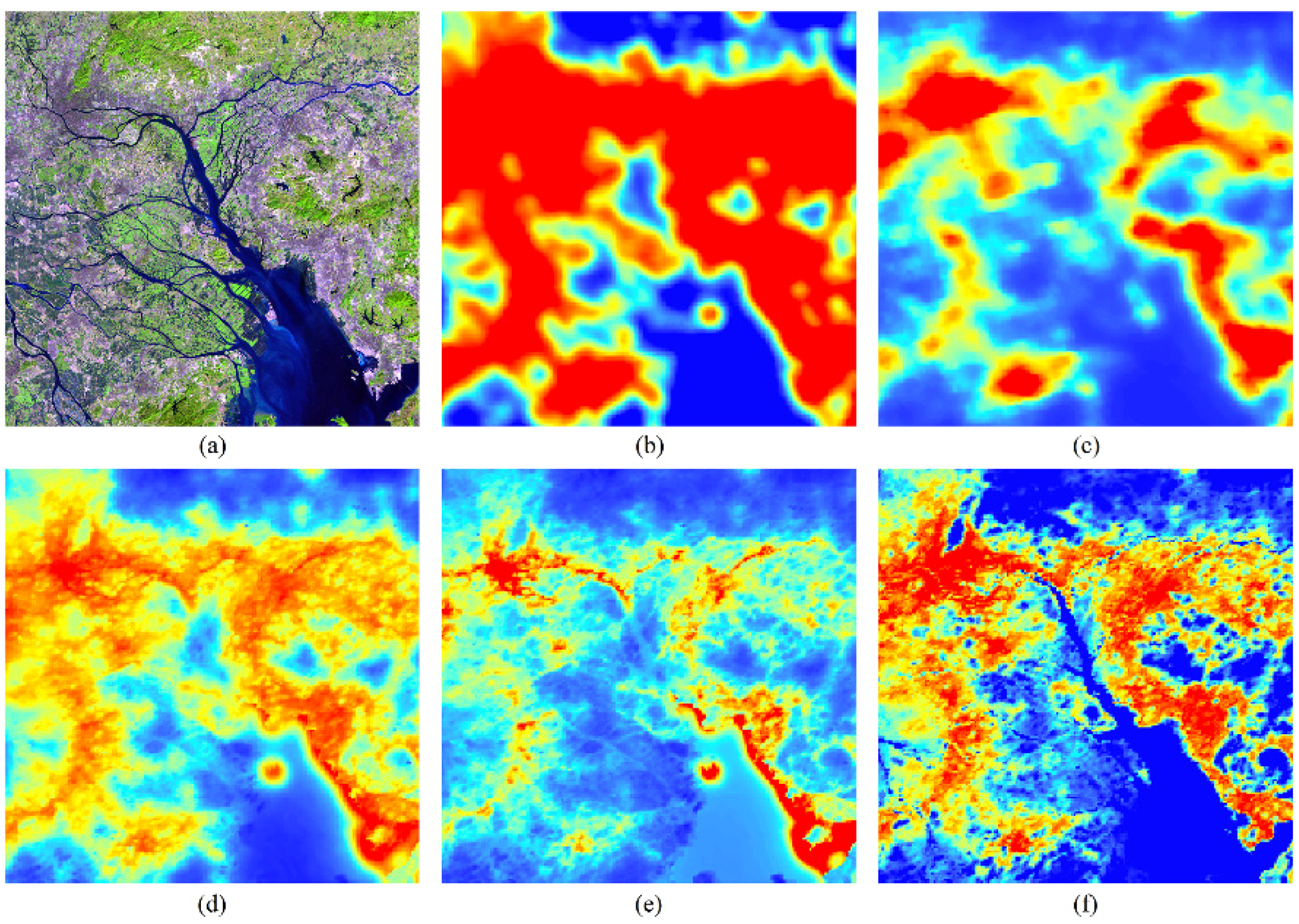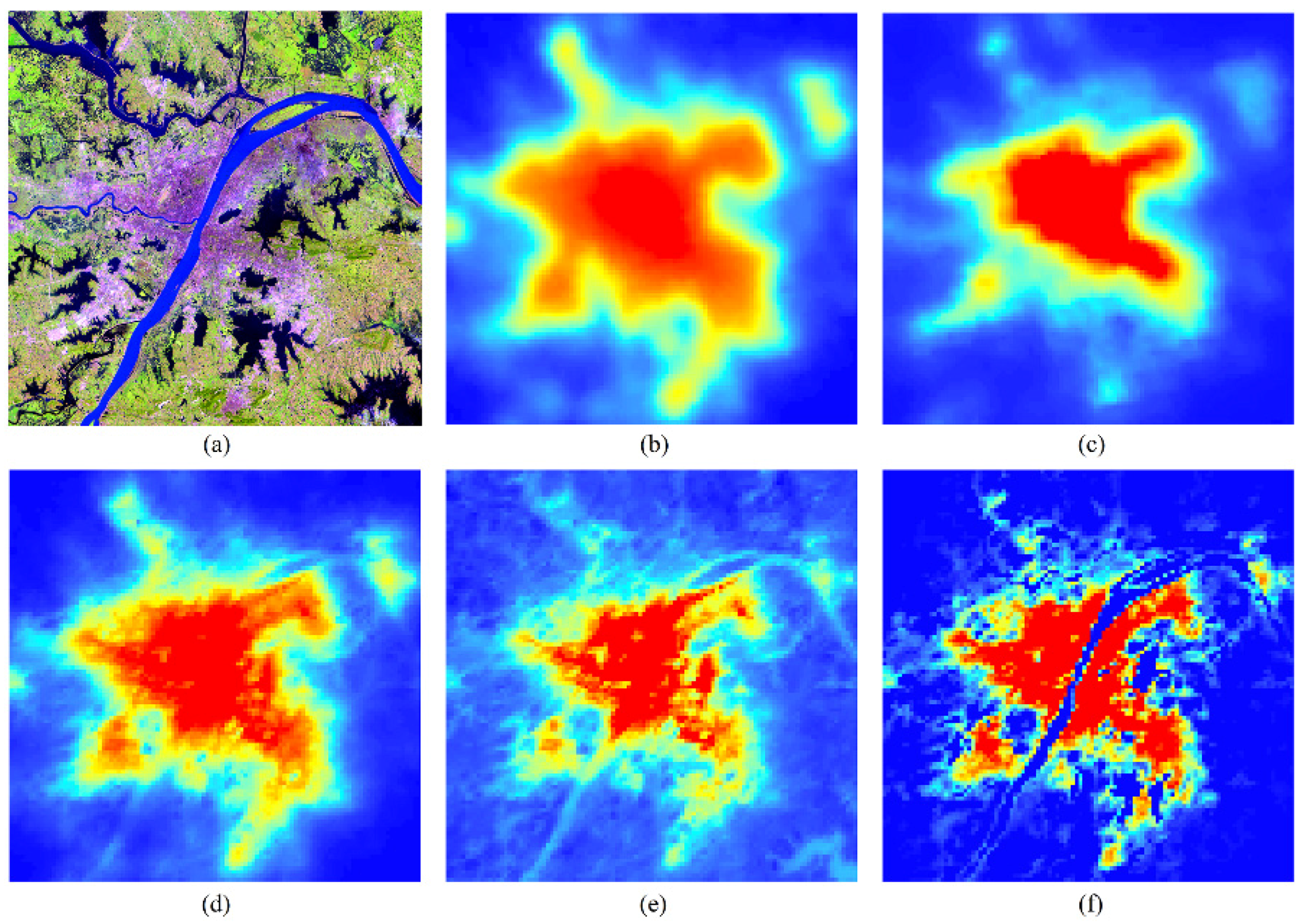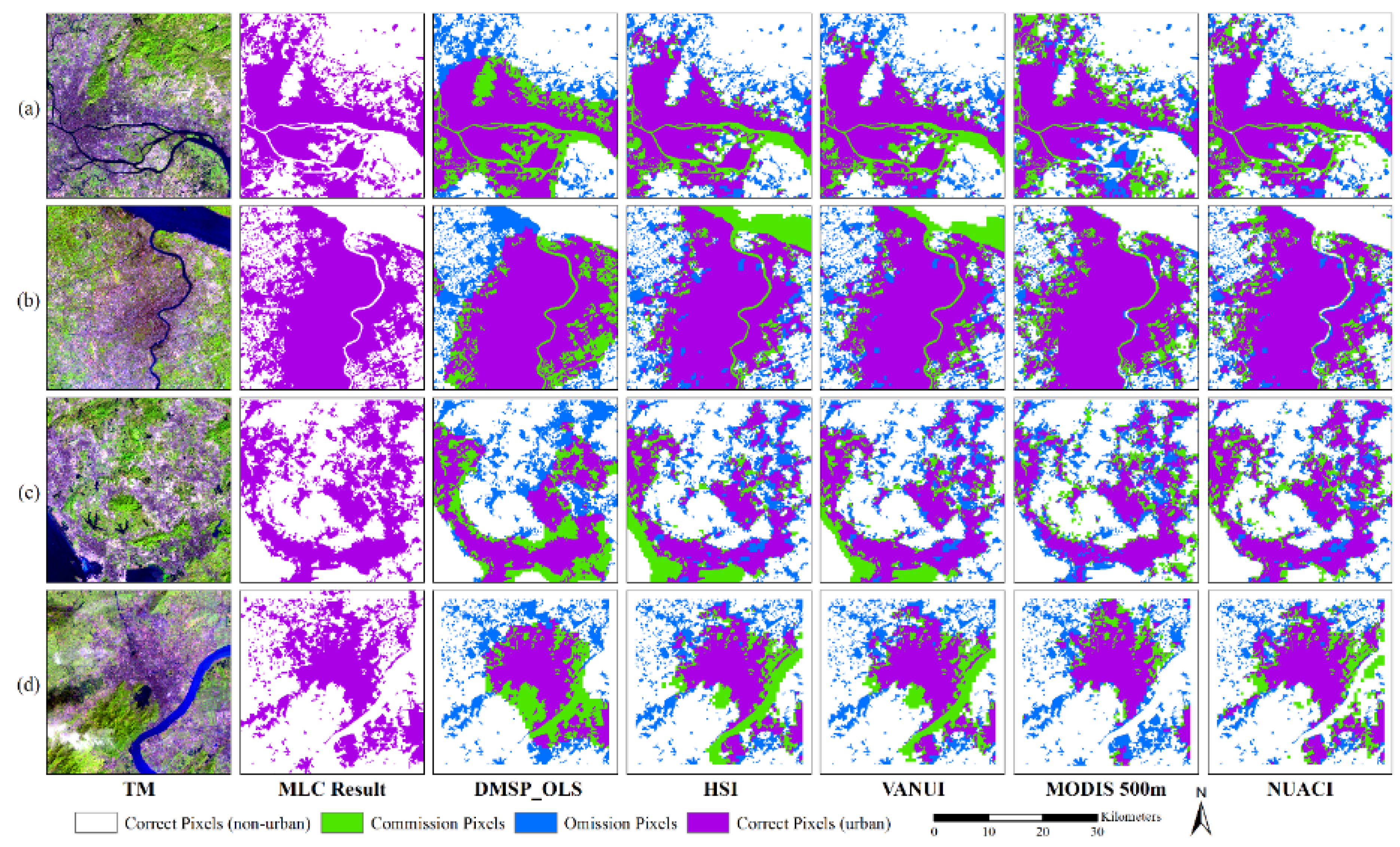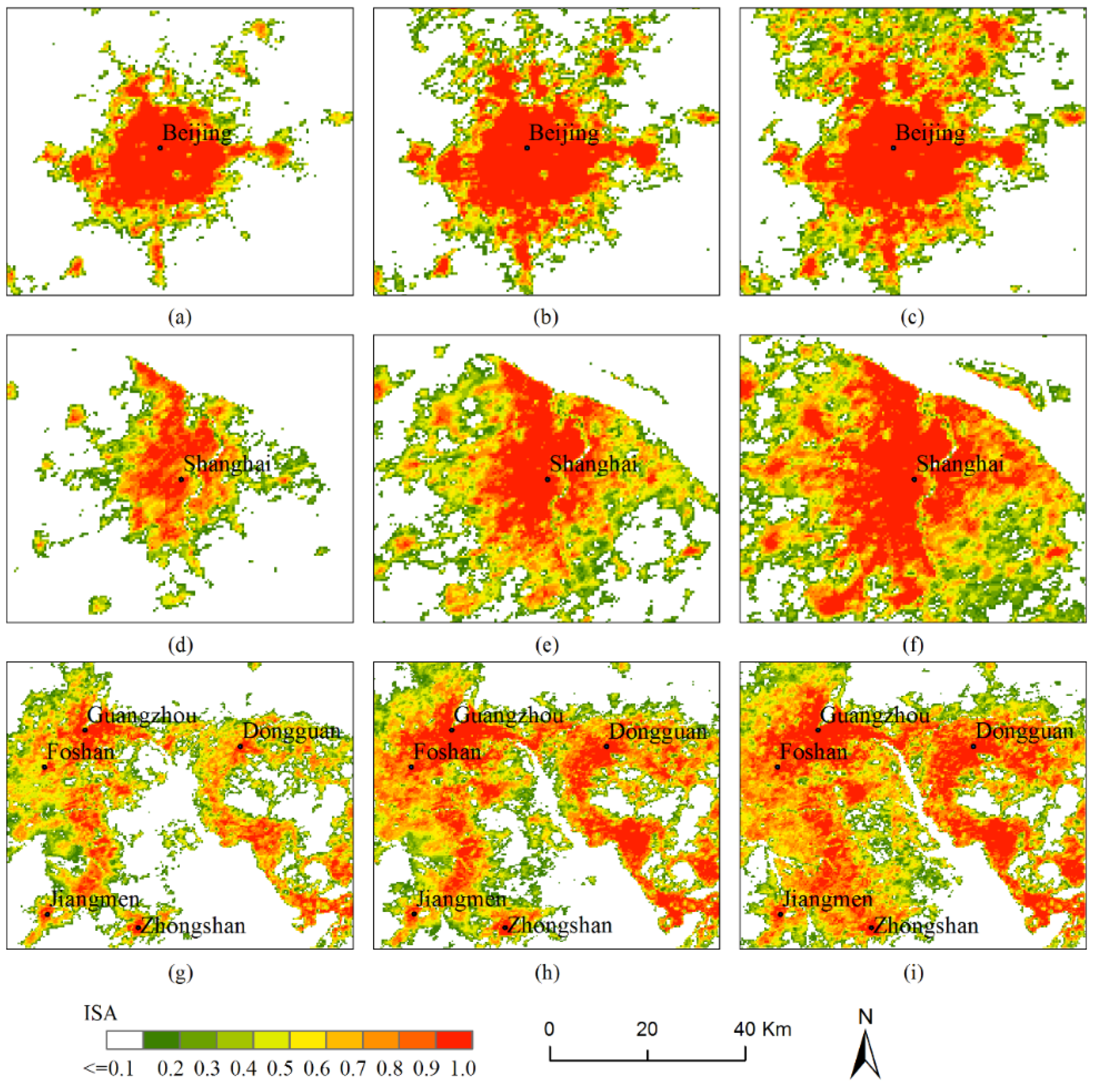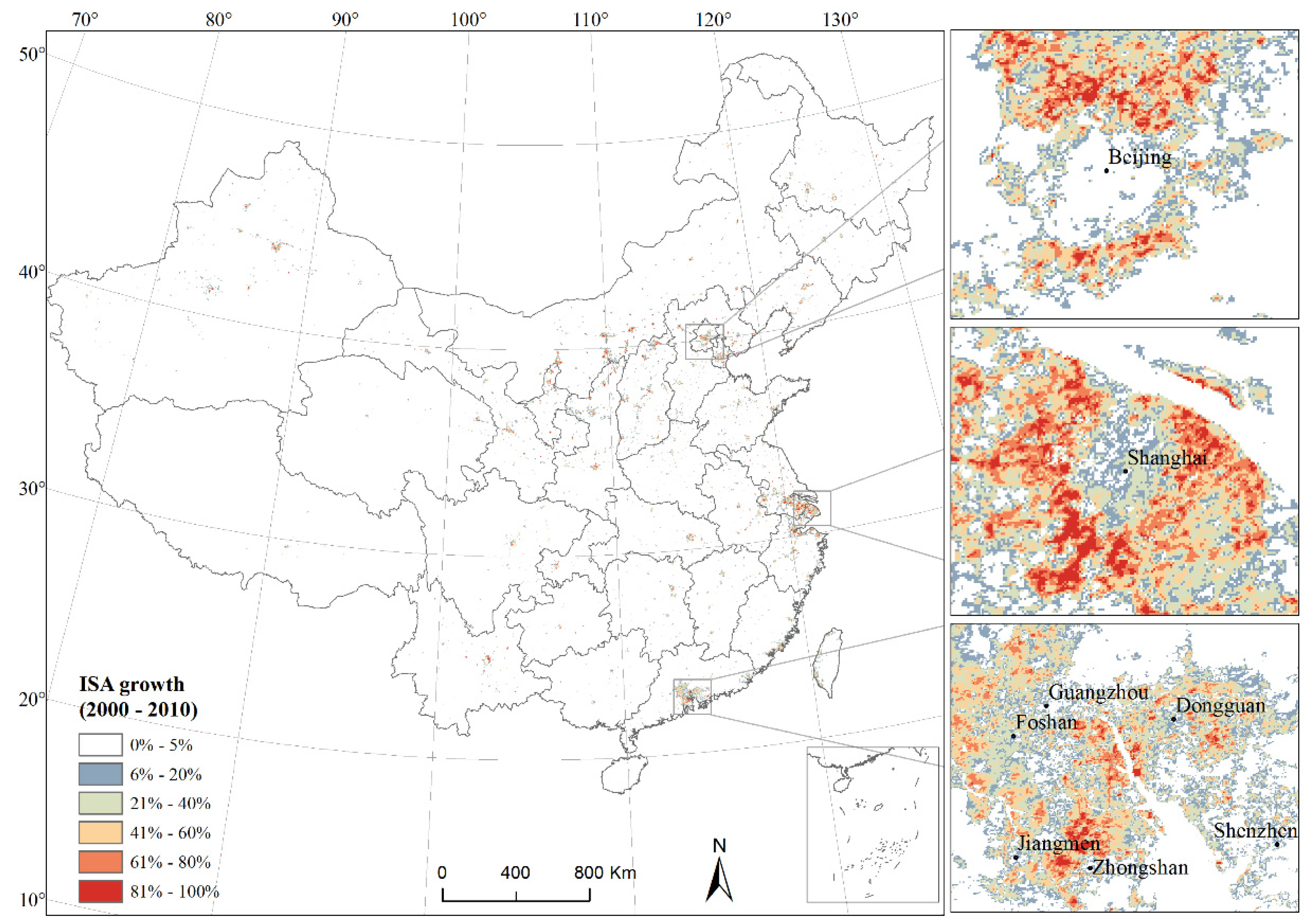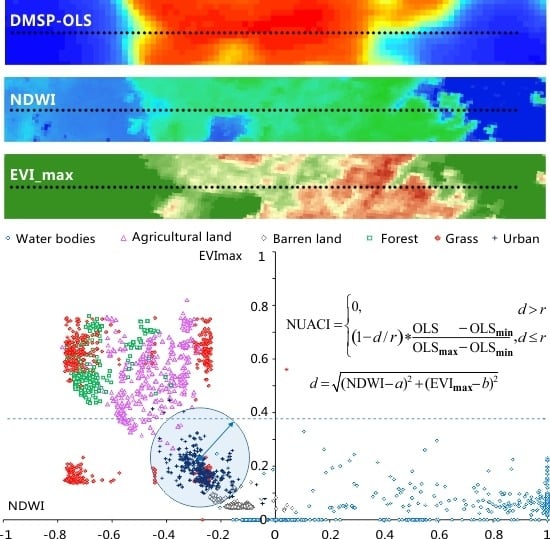5.1. Calculation and Validation of NUACI
Nineteen MODIS surface reflectance data and 16-day composite EVI products covering China were used to obtain NDWI and EVI
max, respectively. The NUACI for the whole of China was then calculated using the combination of DMSP-OLS, NDWI and EVImax images with ArcMap model builder, which is used to implement GIS processes by linking input data automatically. The parameters
a,
b and
r in Equation (1) must be determined before implementing NUACI calculation for the study region. Urban samples collected from ETM+ can be used to determine the
a,
b and
r parameters. We calculated the average values of NDWI and EVI
max for urban samples to obtain the values of
a and
b. The parameter
r can be set by calculating the distance between the farthest urban sample and the central urban sample, the position of which is given as (
a,
b). In this paper, the parameters
a,
b and
r were finally set to −0.35, 0.15 and 0.4, respectively. Six cities undergoing rapid urbanization, including Beijing, Tianjin, Hangzhou, Guangzhou, Shenzhen, and Wuhan, were selected to make the comparison between the NUACI data and the NTL images. As shown in
Figure 5, NTL values were kept invariant in the urban core because of pixel saturation. Furthermore, the blooming effect caused pixels scattered near urban periphery to exhibit high DN values in NTL images. Non-urban land cover within peri-urban areas can be effectively separated from urban lands by using NUACI.
To further evaluate the ability of NUACI on reducing pixel saturation and eliminating the blooming effect, a visual comparison was performed between NUACI, NTL, calibrated NTL without saturation, VANUI and HSI for a latitudinal transect in Shenzhen (
Figure 6). It was apparent that the spatial pattern of NUACI is similar to those of VANUI and HSI. However, NUACI values vary within the urban core, increase toward the urban core, and decrease away from the urban core. The comparison illustrated that although these three indices can reduce pixel saturation and increase inter-urban variability, NUACI values have more variations within urban areas. More importantly, both VANUI and HSI are incapable of reducing the blooming effect because their values for non-urban land cover around the peri-urban areas are still high. In contrast, NUACI values for those areas are very low—almost equal to zero. This result indicates that NUACI has the ability to solve the pixel blooming problem.
Figure 7 and
Figure 8 also display visual comparisons among corrected images selected from the Pearl Delta and from the city of Wuhan as sample areas. The shoreline or riverbank located in the cities is apparently affected by pixel blooming in the NTL data. Pixel blooming is most evident on the imagery where glints of light into adjacent water bodies can be observed. As illustrated in
Figure 7 and
Figure 8, both VANUI and HSI are incapable of separating water bodies from urban areas, whereas NUACI can accurately capture the spatial distribution information of urban areas.
Figure 5.
Comparison of Landsat ETM+ images (a); NTL data (b); and NUACI images (c) for six cities.
Figure 5.
Comparison of Landsat ETM+ images (a); NTL data (b); and NUACI images (c) for six cities.
Further quantitative assessment was carried out to validate the performance of the proposed NUACI index on eliminating the blooming effect. In this experiment, the Pearl River Delta was selected as the sample area. The values of areas located within present urban lands were discussed and analyzed in detail. Urban lands were retrieved from TM/ETM+ images covering the Pearl River Delta, a total of six buffers around existing urban areas within an interval distance of 0.5 km were designated. The mean values of those buffer areas were then calculated for different urban indices. Theoretically, DN values for those non-urban areas should equal zero. However, the buffer areas may show different mean values because of the blooming effect. When lower mean values appear in the corrected images, we can consider the blooming effect extremely restrained.
Table 2 shows the average values for different indices based on images within six buffers. The lowest average values were obtained from the NUACI-based images, which were less than those from DMSP-OLS, HSI, and VANUI images in all the buffer areas.
Figure 9 shows a visual comparison of value distribution pattern among the different urban indices images. The scope of blooming effects is obviously reduced and sometimes even eliminated in the NUACI images. When the buffer area contains large-scale water bodies, the values of NUACI are approximately zero, whereas pixels within the buffer areas for the other urban indices images show high values because of the remaining blooming effect.
Figure 6.
Latitudinal transects of calibrated NTL, saturated NTL, NUACI, HSI, and VANUI for Shenzhen, China.
Figure 6.
Latitudinal transects of calibrated NTL, saturated NTL, NUACI, HSI, and VANUI for Shenzhen, China.
Figure 7.
Comparison of different indexes. (a) Landsat ETM+ images; (b) saturated NTL; (c) calibrated NTL; (d) VANUI; (e) HIS; and (f) NUACI for the Pearl River Delta, China.
Figure 7.
Comparison of different indexes. (a) Landsat ETM+ images; (b) saturated NTL; (c) calibrated NTL; (d) VANUI; (e) HIS; and (f) NUACI for the Pearl River Delta, China.
Figure 8.
Comparison of different indexes. (a) Landsat ETM+ images; (b) saturated NTL; (c) calibrated NTL; (d) VANUI; (e) HIS; and (f) NUACI for Wuhan, China.
Figure 8.
Comparison of different indexes. (a) Landsat ETM+ images; (b) saturated NTL; (c) calibrated NTL; (d) VANUI; (e) HIS; and (f) NUACI for Wuhan, China.
Figure 9.
Comparison of Landsat TM/ETM+ images, saturated NTL, VANUI, HSI, and NUACI for buffer areas: (a) Dongguan; (b) Zhuhai; (c) Guangzhou; (d) Shenzhen; and (e) Huizhou.
Figure 9.
Comparison of Landsat TM/ETM+ images, saturated NTL, VANUI, HSI, and NUACI for buffer areas: (a) Dongguan; (b) Zhuhai; (c) Guangzhou; (d) Shenzhen; and (e) Huizhou.
Table 2.
Comparison of the average values within different buffer areas.
Table 2.
Comparison of the average values within different buffer areas.
| City | 0.5 km | 1 km | 1.5 km |
| OLS | HSI | VANUI | NUACI | OLS | HSI | VANUI | NUACI | OLS | HSI | VANUI | NUACI |
| Foshan | 0.5326 | 1.4353 | 0.3640 | 0.2669 | 0.4771 | 1.2940 | 0.3236 | 0.2297 | 0.4424 | 1.2120 | 0.2987 | 0.2087 |
| Guangzhou | 0.4042 | 0.9953 | 0.2472 | 0.1364 | 0.3442 | 0.8680 | 0.2069 | 0.1037 | 0.3101 | 0.8082 | 0.1857 | 0.0886 |
| Huizhou | 0.2257 | 0.5773 | 0.1220 | 0.0431 | 0.1816 | 0.5108 | 0.0957 | 0.0290 | 0.1541 | 0.4766 | 0.0804 | 0.0223 |
| Dongguan | 0.8232 | 1.9550 | 0.5233 | 0.3224 | 0.7883 | 1.8401 | 0.4934 | 0.2799 | 0.7597 | 1.7724 | 0.4730 | 0.2566 |
| Shenzhen | 0.7572 | 1.9056 | 0.4385 | 0.1823 | 0.7064 | 2.0489 | 0.4104 | 0.1452 | 0.6696 | 2.2156 | 0.3977 | 0.1294 |
| Zhongshan | 0.6499 | 1.3683 | 0.3945 | 0.2301 | 0.6060 | 1.2739 | 0.3651 | 0.2042 | 0.5767 | 1.2167 | 0.3460 | 0.1889 |
| Zhuhai | 0.3360 | 0.9272 | 0.2052 | 0.0870 | 0.3030 | 0.9436 | 0.1903 | 0.0742 | 0.2777 | 0.9643 | 0.1791 | 0.0659 |
| City | 2 km | 2.5 km | 5 km |
| OLS | HSI | VANUI | NUACI | OLS | HSI | VANUI | NUACI | OLS | HSI | VANUI | NUACI |
| Foshan | 0.4229 | 1.1671 | 0.2846 | 0.1977 | 0.4083 | 1.1315 | 0.2739 | 0.1894 | 0.3571 | 1.0127 | 0.2371 | 0.1610 |
| Guangzhou | 0.2865 | 0.7673 | 0.1713 | 0.0799 | 0.2693 | 0.7353 | 0.1606 | 0.0743 | 0.2169 | 0.6367 | 0.1278 | 0.0578 |
| Huizhou | 0.1360 | 0.4563 | 0.0707 | 0.0188 | 0.1220 | 0.4408 | 0.0633 | 0.0163 | 0.0886 | 0.4063 | 0.0457 | 0.0109 |
| Dongguan | 0.7360 | 1.7257 | 0.4578 | 0.2423 | 0.7154 | 1.6886 | 0.4453 | 0.2321 | 0.6624 | 1.5885 | 0.4136 | 0.2091 |
| Shenzhen | 0.6427 | 2.3297 | 0.3894 | 0.1166 | 0.6242 | 2.4109 | 0.3857 | 0.1083 | 0.5580 | 2.3948 | 0.3629 | 0.0877 |
| Zhongshan | 0.5543 | 1.1837 | 0.3326 | 0.1792 | 0.5362 | 1.1639 | 0.3224 | 0.1722 | 0.4904 | 1.1131 | 0.2958 | 0.1521 |
| Zhuhai | 0.2548 | 0.9892 | 0.1681 | 0.0586 | 0.2360 | 1.0119 | 0.1586 | 0.0532 | 0.1669 | 1.0565 | 0.1175 | 0.0333 |
Additionally, urban indices such as HSI and VANUI have been directly applied to extract the extent of urban areas by using the threshold segmentation method. The accuracy of urban land extraction can reflect the efficiency on reducing the blooming effect. In this paper, we extracted urban areas using the proposed NUACI. We selected a total of eleven cities as samples. Urban areas obtained from normalized DMSP-OLS, HSI, and VANUI images were further evaluated to validate the efficiency of NUACI in eliminating the blooming effect. In addition, urban land extracted from the MODIS land-use products with a resolution of 500 m, which were generated using SVM methods [
2], were also downloaded for comparison purposes. The total area of urban lands was derived from Landsat TM/ETM+ images using the MLC method and used as actual reference data. Corresponding equal areas of urban land for each sample city were retrieved from DMSP-OLS NTL data, MODIS land-use data, HSI image, VANUI image, and NUACI image, respectively. Quantitative indices including Kappa coefficient and overall accuracy were calculated by means of point-to-point comparison. The results were applied to measure the performance of deriving urban areas with these different combinations.
Figure 10,
Figure 11 and
Figure 12 show the spatial distribution of classification accuracy, commission errors, and omission errors on urban areas derived from the different images from 2000, 2005, and 2010. All the results derived from NUACI exhibit lower commission and omission errors in all the sample areas. The spatial patterns are generally similar to those derived from MODIS land-use data. Within the time variation, the spatial patterns of urban lands obtained with NUACI method for the selected cities are more rational than those from MODIS land-use data. Higher commission errors (in green) generally presented in the urban areas extracted from DMSP-OLS NTL because of the blooming effect on the coastal area, rivers, vegetation covered lands, barren lands and water bodies. The results derived from HSI and VANUI can reduce the blooming effect on vegetation covered areas, which also reduces commission errors on vegetation covered lands. In addition, the blooming effect on coastal areas, rivers and large-scale water bodies are further efficiently reduced by using NUACI, although a few commission errors were distributed along small-scale rivers. The densities of omission pixels also decreased in the extracted urban areas when using the NUACI method. In addition, results derived from MODIS land-use data presented higher omission errors than those from NUACI in regions with low urban land densities. As shown in
Table 3,
Table 4 and
Table 5, almost all the cities show the highest Kappa coefficients and overall accuracy of urban areas when extracted from NUACI compared with those from DMSP-OLS, HSI, VANUI, and the MODIS data.
Figure 10.
Comparison of the results of extracting urban lands by the Threshold Segmentation Method in the year 2000: (a) Guangzhou; (b) Shanghai; (c) Shenzhen; and (d) Hangzhou.
Figure 10.
Comparison of the results of extracting urban lands by the Threshold Segmentation Method in the year 2000: (a) Guangzhou; (b) Shanghai; (c) Shenzhen; and (d) Hangzhou.
Figure 11.
Comparison of the results of extracting urban lands by the Threshold Segmentation Method in the year 2005: (a) Guangzhou; (b) Shanghai; (c) Shenzhen; and (d) Hangzhou.
Figure 11.
Comparison of the results of extracting urban lands by the Threshold Segmentation Method in the year 2005: (a) Guangzhou; (b) Shanghai; (c) Shenzhen; and (d) Hangzhou.
Figure 12.
Comparison of the results of extracting urban lands by the Threshold Segmentation Method in the year 2010: (a) Guangzhou; (b) Shanghai; (c) Shenzhen; and (d) Hangzhou.
Figure 12.
Comparison of the results of extracting urban lands by the Threshold Segmentation Method in the year 2010: (a) Guangzhou; (b) Shanghai; (c) Shenzhen; and (d) Hangzhou.
Table 3.
Kappa and overall accuracy of extracting urban land in 2000.
Table 3.
Kappa and overall accuracy of extracting urban land in 2000.
| Name | Urban Area (KM2) | Kappa | Overall Accuracy |
|---|
| DMSP | HSI | VANUI | MODIS 500 m | NUACI | DMSP | HSI | VANUI | MODIS 500 m | NUACI |
|---|
| Beijing | 1047 | 0.5550 | 0.6329 | 0.6224 | 0.5567 | 0.6393 | 0.7795 | 0.8181 | 0.8129 | 0.7817 | 0.8213 |
| Shanghai | 760 | 0.5432 | 0.5376 | 0.4496 | 0.5549 | 0.6279 | 0.7720 | 0.7692 | 0.7253 | 0.7801 | 0.8143 |
| Guangzhou | 546 | 0.4935 | 0.4667 | 0.3786 | 0.4459 | 0.4916 | 0.8013 | 0.7851 | 0.7384 | 0.7517 | 0.8023 |
| Shenzhen | 606 | 0.4404 | 0.4763 | 0.2946 | 0.5245 | 0.5931 | 0.7367 | 0.7682 | 0.6709 | 0.7966 | 0.8344 |
| Wuhan | 323 | 0.5078 | 0.5189 | 0.3564 | 0.6202 | 0.6009 | 0.8383 | 0.8419 | 0.7488 | 0.8636 | 0.8689 |
| Nanjing | 257 | 0.4660 | 0.4778 | 0.3923 | 0.4369 | 0.5566 | 0.7396 | 0.7454 | 0.7037 | 0.7399 | 0.7838 |
| Chongqing | 204 | 0.5417 | 0.5701 | 0.5193 | 0.5188 | 0.5739 | 0.8396 | 0.8495 | 0.8318 | 0.8262 | 0.8508 |
| Dalian | 281 | 0.5712 | 0.4651 | 0.0081 | 0.6293 | 0.6939 | 0.8858 | 0.8491 | 0.4029 | 0.8986 | 0.9186 |
| Hangzhou | 174 | 0.3606 | 0.3728 | 0.3587 | 0.5104 | 0.4548 | 0.7427 | 0.7481 | 0.7423 | 0.8044 | 0.7808 |
| Changsha | 129 | 0.4229 | 0.4369 | 0.3782 | 0.4677 | 0.4398 | 0.7714 | 0.7769 | 0.7537 | 0.7786 | 0.7781 |
| Xiamen | 107 | 0.2808 | 0.1655 | −0.0090 | 0.3012 | 0.4070 | 0.8370 | 0.6967 | 0.3913 | 0.7669 | 0.8660 |
Table 4.
Kappa and overall accuracy of extracting urban land in 2005.
Table 4.
Kappa and overall accuracy of extracting urban land in 2005.
| Name | Urban Area (km2) | Kappa | Overall Accuracy |
|---|
| DMSP | HSI | VANUI | MODIS 500 m | NUACI | DMSP | HSI | VANUI | MODIS 500 m | NUACI |
|---|
| Beijing | 1236 | 0.5610 | 0.5989 | 0.5994 | 0.5020 | 0.6058 | 0.7993 | 0.8168 | 0.8168 | 0.7625 | 0.8198 |
| Shanghai | 882 | 0.4816 | 0.4564 | 0.5103 | 0.5909 | 0.6031 | 0.7523 | 0.7399 | 0.7657 | 0.8080 | 0.8101 |
| Guangzhou | 799 | 0.4566 | 0.5134 | 0.5244 | 0.4934 | 0.5420 | 0.7421 | 0.7691 | 0.7743 | 0.7593 | 0.7828 |
| Shenzhen | 813 | 0.4150 | 0.4276 | 0.4841 | 0.4694 | 0.5979 | 0.7238 | 0.7300 | 0.7566 | 0.7559 | 0.8103 |
| Wuhan | 417 | 0.5030 | 0.5107 | 0.5271 | 0.5991 | 0.5791 | 0.8052 | 0.8083 | 0.8147 | 0.8444 | 0.8351 |
| Nanjing | 337 | 0.4501 | 0.4192 | 0.4532 | 0.2861 | 0.5001 | 0.7282 | 0.7130 | 0.7298 | 0.6232 | 0.7529 |
| Chongqing | 250 | 0.4817 | 0.5395 | 0.5342 | 0.4940 | 0.5609 | 0.7921 | 0.8151 | 0.8132 | 0.8042 | 0.8238 |
| Dalian | 296 | 0.5694 | 0.3849 | 0.5095 | 0.6290 | 0.6534 | 0.8804 | 0.8293 | 0.8639 | 0.8964 | 0.9039 |
| Hangzhou | 238 | 0.3369 | 0.3915 | 0.4003 | 0.4665 | 0.4903 | 0.6871 | 0.7127 | 0.7169 | 0.7618 | 0.7594 |
| Changsha | 170 | 0.4165 | 0.4406 | 0.4410 | 0.4317 | 0.4570 | 0.7318 | 0.7428 | 0.7430 | 0.7458 | 0.7503 |
| Xiamen | 166 | 0.3261 | 0.0188 | 0.1469 | 0.4007 | 0.4841 | 0.7835 | 0.6851 | 0.7260 | 0.7810 | 0.8345 |
Table 5.
Kappa and overall accuracy of extracting urban land in 2010.
Table 5.
Kappa and overall accuracy of extracting urban land in 2010.
| Name | Urban Area (km2) | Kappa | Overall Accuracy |
|---|
| DMSP | HSI | VANUI | MODIS 500 m | NUACI | DMSP | HSI | VANUI | MODIS 500 m | NUACI |
|---|
| Beijing | 1675 | 0.4718 | 0.4587 | 0.3900 | 0.1944 | 0.4861 | 0.8852 | 0.8824 | 0.8674 | 0.6448 | 0.8717 |
| Shanghai | 1017 | 0.4460 | 0.3454 | 0.2856 | 0.5448 | 0.5836 | 0.7946 | 0.7232 | 0.6980 | 0.7989 | 0.8241 |
| Guangzhou | 925 | 0.4530 | 0.4140 | 0.2879 | 0.4741 | 0.4820 | 0.7296 | 0.7103 | 0.6479 | 0.7432 | 0.7438 |
| Shenzhen | 969 | 0.4225 | 0.4319 | 0.2888 | 0.4690 | 0.6584 | 0.7102 | 0.7183 | 0.6473 | 0.7427 | 0.8306 |
| Wuhan | 581 | 0.4454 | 0.3918 | 0.2632 | 0.5454 | 0.4976 | 0.7407 | 0.7157 | 0.6468 | 0.8006 | 0.7651 |
| Nanjing | 407 | 0.3255 | 0.4240 | 0.3669 | 0.1918 | 0.5651 | 0.7011 | 0.7448 | 0.7195 | 0.5273 | 0.8073 |
| Chongqing | 335 | 0.4649 | 0.5314 | 0.5450 | 0.4354 | 0.5560 | 0.7501 | 0.7811 | 0.7875 | 0.7548 | 0.7926 |
| Dalian | 368 | 0.6169 | 0.4505 | 0.0366 | 0.6203 | 0.6914 | 0.8658 | 0.7843 | 0.4127 | 0.8837 | 0.8987 |
| Hangzhou | 256 | 0.3362 | 0.3904 | 0.3874 | 0.4446 | 0.5061 | 0.6778 | 0.7048 | 0.7033 | 0.7446 | 0.7608 |
| Changsha | 263 | 0.4335 | 0.4430 | 0.4026 | 0.3281 | 0.4885 | 0.7202 | 0.7250 | 0.7049 | 0.6511 | 0.7474 |
| Xiamen | 231 | 0.3015 | 0.0730 | -0.0636 | 0.4348 | 0.5964 | 0.7182 | 0.5220 | 0.3787 | 0.7735 | 0.8373 |
5.2. Estimation of ISA with NUACI
The quantitative and visual comparison validated incorporating EVI and NDWI to efficiently reduce the blooming effect and saturation limitation. NUACI has the ability to retrieve accurate urban information using the coarse resolution NTL data. In actuality, mapping the national urban fraction is more attractive and has increased interest in using the coarse resolution images. ISA has been considered as an important indicator for measuring the degree of urbanization. Numerous studies have shown that NTL data were positively correlated with ISA data [
14,
21,
39]. A regression model was thus established with the NUACI for estimating the density of ISA for the whole of China. In the linear regression model, the aggregated ISA data derived from the retrieved thirty scenes of Landsat TM/ETM+ classification results were used as reference data (dependent variable), while NUACI was used as a single independent variable. ISA extracted from regression models based on normalized DMSP-OLS, VANUI and HSI were used in the comparison to evaluate the ability of NUACI to extract urban fractions. Correlation coefficients between the estimated ISA and the reference data were used to examine the performance of the regression models. In addition, the root-mean square error (RMSE), which is a quadratic scoring rule available to measure the average magnitude of the error, was used to perform an accuracy assessment. RMSE can be calculated as follows:
where
N is the number of samples, and
pi and
ti are the measured and estimated values, respectively.
Five thousand sample plots were randomly selected from the reference data. From those, 3000 samples were used as the training data to establish regression models corresponding to normalized DMSP-OLS, NUACI, VANUI and HSI, respectively. The remaining 2000 samples were used to calculate quantitative indices including the coefficient of determination (
R2), the correlation coefficient (
R) and RMSE for validating the regression models. The estimation and validation were performed using Matlab, a programming language developed by MathWorks [
40].
Table 6 lists the regression models and the calculated evaluation indices. It shows that the
R2 value of regression models based on DMSP-OLS, HSI, VANUI, and NUACI are 0.4459, 0.6888, 0.7822, and 0.8079, respectively. The regression models using VANUI or NUACI as the independent variable provide comparatively higher
R2 values than those based on normalized DMSP-OLS or HSI. The NUACI-based regression model has the highest
R2 value of 0.8079. This result implies that NUACI could be the most suitable method for estimating ISA. In contrast, the DMSP-OLS-based regression model has the lowest
R2 value of 0.4459. The results for correlation coefficients (
R) were similar to the
R2 values. The NUACI-based regression model has the highest
R value (0.8908), while the DMSP-OLS, HSI and VANUI based regression models had
R values of 0.6680, 0.8241 and 0.8695, respectively. This implies that the NUACI-based regression model has the best performance for testing samples. Moreover, the RMSE of the NUACI-based regression model shows the lowest value of 0.1176. The scatterplots (
Figure 13) generated using the estimations and the reference data also demonstrate that there is higher correlation between ISA and NUACI or VANUI than between ISA and other urban indices. In addition, the three regression models other than the NUACI model are inclined to overestimate the fraction values for some pixels that have zero value (horizontal axis). This indicates that the NUACI-based regression model can successfully reduce the blooming effect and achieve better estimation accuracy of ISA than other models.
Table 6.
Regression models based on different variables for estimating ISA.
Table 6.
Regression models based on different variables for estimating ISA.
| Variable Used | Regression Model (y = ax + b) | R2 | R | RMSE |
|---|
| DMSP | ISA = 2.589DMSP − 0.159 | 0.4459 | 0.6680 | 0.1667 |
| HSI | ISA = 0.669HSI − 0.825 | 0.6888 | 0.8241 | 0.1541 |
| VANUI | ISA = 3.222VANUI − 1.307 | 0.7822 | 0.8695 | 0.1458 |
| NUACI | ISA = 1.701NUACI − 0.261 | 0.8079 | 0.8908 | 0.1176 |
According to the comparison above, NUACI can perform efficiently for retrieving the ISA distribution in the sample area. Therefore, the NUACI-based regression models were applied to the estimation of ISA in 2000, 2005 and 2010 for the whole of China. As shown in
Table 7, there are some variations in the parameters of regression models for different years. The regression model in 2005 has the highest estimation accuracy. Overall, a large proportion of ISA are distributed in the eastern regions, especially in the Pearl River Delta, Yangtze River Delta and Beijing-Tianjin-Tangshan metropolitan areas as shown in
Figure 14. The ISA growth distributions from 2000 to 2010 are shown in
Figure 15, which illustrates that the Pearl River Delta, Yangtze River Delta and Beijing-Tianjin-Tangshan metropolitan areas are the three major regions with high ISA growth rates. In particular, the highest ISA expansion rates occur in the Yangtze River Delta.
Figure 15 also demonstrates that medium and small cities surrounding megacities have rapid ISA growth rates because of the radiation effect.
Figure 13.
Comparison of the scatterplots between the estimated ISA and the reference data.
Figure 13.
Comparison of the scatterplots between the estimated ISA and the reference data.
Table 7.
Regression models for estimating ISA based on NUACI in 2000, 2005 and 2010.
Table 7.
Regression models for estimating ISA based on NUACI in 2000, 2005 and 2010.
| Year | Regression Model (y = ax + b) | R2 | R | RMSE |
|---|
| 2000 | ISA = 1.750*NUACI − 0.430 | 0.7914 | 0.8413 | 0.1400 |
| 2005 | ISA = 1.701*NUACI − 0.261 | 0.8079 | 0.8908 | 0.1176 |
| 2010 | ISA = 1.669*NUACI − 0.121 | 0.7834 | 0.7382 | 0.1393 |
Figure 14.
Estimated ISA of the three metropolitan areas in the years 2000, 2005 and 2010 using the NUACI-based regression model: (a–c) ISA estimated for the Beijing-Tianjin-Tangshan metropolitan areas in 2000, 2005, and 2010; (d–f) ISA estimated for the Yangtze River Delta in 2000, 2005, and 2010; and (g–i) ISA estimated for the Pearl River Delta in 2000, 2005, and 2010.
Figure 14.
Estimated ISA of the three metropolitan areas in the years 2000, 2005 and 2010 using the NUACI-based regression model: (a–c) ISA estimated for the Beijing-Tianjin-Tangshan metropolitan areas in 2000, 2005, and 2010; (d–f) ISA estimated for the Yangtze River Delta in 2000, 2005, and 2010; and (g–i) ISA estimated for the Pearl River Delta in 2000, 2005, and 2010.
Figure 15.
The growth pattern of ISA from 2000 to 2010 in China.
Figure 15.
The growth pattern of ISA from 2000 to 2010 in China.
